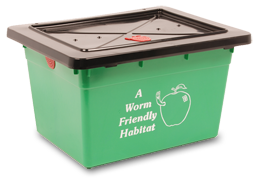At Busch Systems reducing, reusing and recycling is a high priority; we’re always looking for more ways to divert waste, which is why we are big believers in composting. Did you know that composting can divert over 32 million tons of organic waste from landfills a year?
Generally when the term composting is used, it’s referring to hot (or thermophilic) composting, which is of course an excellent way to reduce diversion rates. However the perhaps lesser known vermiculture or vermicomposting process, is quite effective as well and can even be superior.
But what is vermicomposting and how does it work?
The process uses worms rather than sunlight to decompose waste; the worms eat organic scraps and create humus – a nutrient rich organic fertilizer. This can be used to enhance your garden or indoor plants and it is a highly efficient way to decompose your kitchen scraps; you can easily process ½ lb of kitchen scraps a day. Best of all it can be done right in your home or apartment, so you can continue composting no matter what the weather is like!
To start a vermicultural system you’ll need some shredded paper, red worms (1lb of red worms for every ½ lb of kitchen scraps daily) and of course a container. First create bedding for the worms by dampening shredded paper and laying it on the bottom of the bin, ensuring the entire bottom of it is covered. Next place the worms on the bedding and find a good place to store the container. For the red worms to thrive they need to be in a dark environment and stored in a temperature between 70°F and 80°F (21°C to 26°C). Also be sure the location allows for air circulation, because just like humans worms need to breathe. Finally start adding kitchen scraps and let the worms do their magic; you will be amazed at the results!

Vermi Composter from Busch Systems
Now rather than making your own container or simply using a regular bin for this purpose, we have made it easy. Our Vermi Composter container is specifically designed for it, it’s lightweight, easy to use and it has three red apple vents for air circulation. So why not give the worm a turn and give a vermiculture system a try?
by Andrew Sutherland“






